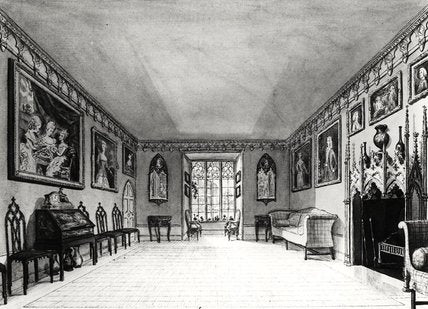The Strawberry Hill Chair
Share

Rummaging around on the internet, I came across an old friend: The Strawberry Hill Chair, in the collection of the Victoria & Albert Museum, London. I am sure you know all about Strawberry Hill, the extraordinary Gothick house sited on the banks of the River Thames, near Twickenham, to the West of London. Originally a cottage (or small-ish villa) it was re-built by Horace Walpole (the son of the Prime Minister, Robert) at various stages during the eighteenth century: reimagined as a Gothick fantasy in the manner of an abbey, monastary or castle, or at least how, in the 18th century, they thought one should look like. It has recently re-opened to the general public, and if you have the time and inclination, I urge you to go. I love the place.

Horace Walpole was a connoisseur of the exotic, a dilattante, collector, antiquarian and aesthete; an admirer of Medieval architecture. Strawberry Hill has a playful atmosphere: this is a house intended for fun and frolics; an antiquarian fantasy, a make-believe haunted abbey of the imagination, an amusing weekend pastiche for Horace and his friends- away from the hubbub and bustle of London. I have no doubt that in his own mind, Horace was building his own "Castle of Otranto".

The Castle of Otranto was first published in 1764, considered by critics to be the first "Gothic Novel". This strange melodrama, if I remember correctly, features an ancient Italian fortress and a giant ghost helmet which crushes the hero to death in the first chapter. Horace claimed to have discovered the manuscript in the library of "an ancient Catholic family in the North of England". The truth was, of course, that he wrote it himself.
By the mid 18th century, a preference for "All Things Spooky" had become very much the rage, with fashionable society obsessed with macabre yarns involving werewolves, vampyres, lonely hermits, lavicious monks, and all manner of creepy crawlies, nasties, long legg-ed beasties and things that go bump in the night. Gothic Fiction has never really gone out of fashion (think of the success of Bram Stoker's Dracula or Mary Shelley's Frankenstein, both re-invented by Universal Studios in the 1930's) but the Gothick craze had reached such a height that by 1798, Jane Austen was able to lampoon the genre in her amusing- and very readable- satire, Northanger Abbey.

The chair itself was designed in 1755 by Richard Bentley (a member of a sort of 'taste committee' that Horace had set-up to oversee the redevelopment of Strawberry Hill) and made by the trendy London cabinet maker, William Hallett. The back of the chair was inspired by the window of a Gothic church, and the chair was made from beechwood (a cheap, light-weight and readily available wood) painted to look like the more expensive and exotic wood, ebony. Eight chairs were made to furnish the Great Parlour, and we can clearly see them illustrated in the print below, arranged around the edges of the room- as was the fashion of the day.

In my next post, we'll have a closer look at Strawberry Hill, and I'll put up some of my own photographs I took there on a recent visit.